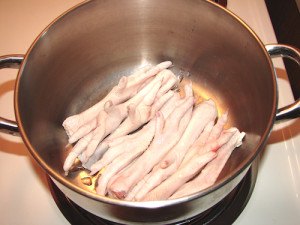My knees have gotten creaky. This might be normal aging, but it concerns me because I want to keep riding my bike for decades to come. Years ago I read a report on the benefits of gelatin for joint health; but I didn’t figure the vegetarian substitutes for gelatin (agar agar, carrageen) would help. (This assumption was not based on any facts. It just seemed like I’d need to eat the real thing.)
I didn’t want to stop being a vegetarian. But I wanted to take care of my knees. I let the idea sit and eventually felt okay about eating gelatin if I met a few conditions: 1) I’d extract it myself, not buy it in a box. 2) I’d use chicken from a local farm (ideally the “scrap” parts – I’d heard good things about the gelatin in stock made from chicken backs and chicken feet). 3) I’d extract as much gelatin as possible, to make the most of the chicken. 4) I’d eat it like medicine, not try to hide it in good-tasting soup. It was still eating meat but no longer felt like a drastic compromise of beliefs.
Recipes for making stock from chicken parts were plentiful. Too plentiful: Bring the water to a boil briefly, don’t let the water boil! Start with chilled water. Pour off the initial boil water and use new water. Add vinegar. Cut the tips off the toes. Rub the feet with salt, scald them, and put them into an ice bath before removing the yellow membrane.
Wait a minute… there was no yellow membrane on my chicken feet! Did this mean I could skip the initial boiling step? Or did my local brand of chicken have membranes of a different color?
I tried asking advice but that didn’t help. My Polish friend (who says that everyone in Poland eats stock from chicken feet and that no one there has joint problems) is of the don’t let it boil! camp. My farmer friend says she lets it boil away, and it always turns out fine.

Here are the herding dogs at Fickle Creek Farm. This photo has nothing to do with gelatin or chicken feet– I just wanted to post a photo of cute sleepy dogs.
So I headed to the university library. I naively imagined finding a few research papers about gelatin extraction: one would have a table filled with chicken parts and maximum-gelatin-extraction temperatures. Of course this didn’t happen. The papers cited many “ideal temperatures,” but the papers were old, or the gelatin was from pig skin, or the research used complicated chemicals that made the results seem irrelevant in the kitchen. The researchers were only interested in the gelling capability of the gelatin, not its health benefits.
Finally it occurred to me that I should have started with the basics, and I pulled out my ancient college biochem textbook. That was a good place to start. Next time I’ll discuss what gelatin is and how it’s usually made. In the meantime, here’s what I’ve learned about boiling chicken feet (and other parts):
1. The first time, I used “chicken backs” which it turns out are chicken carcasses. (I was picturing sort of a miniature spine….) I covered them with water in a large pot and kept the water below boiling. Okay, technically it started boiling at one point, and then it took awhile for the temp to come down because it was so much water. And then my “overnight simmer” ended up being lukewarm by morning. The stock tasted good (too good) and did not gel at all.
2. The second time, I used 4 chicken feet in 2 quarts of water with 1 Tbsp of vinegar. I tried to keep the water temperature above 165F, which is the “safe” temperature for poultry according to the FDA. (foodsafety.gov) I used a thermometer to track it; it once got up to 210F and was looking kind of boil-y. This simmer went on for a few hours…. The final stock (refrigerated) was kind of gloppy but not solid. Also, I hated the way it tasted. (Woo hoo!)
3. Then I got a new oven and lost all the settings I had used for a good simmer. This time I used 8 feet in 2 quarts of water and 1 Tbsp of vinegar. After carefully keeping it below a boil for 2.5 hours, I accidentally let it boil. So I decided to try out boiling it and cranked the heat up. It boiled for about 30 minutes. It made a stock that was much more gloppy–parts of it were downright solid.
If you’d like to follow a more coherent recipe with nice photos, here are two:
http://www.simplyrecipes.com/recipes/how_to_make_stock_from_chicken_feet/
http://nourishedkitchen.com/chicken-feet-stock/
More soon!




I’m so glad you included the super cute dogs! I can’t wait for the follow up.
Thanks, Josh!
Pingback: Chicken Feet 2: Collagen | Food Chem Blog
Have you noticed any different in joint health since eating chicken feet? I am thinking about doing this too.
Hi Michelle, Ultimately, I didn’t feel any different. I stopped making the gelatin after a few months because it took time and I really disliked eating it. But it was all a highly unscientific experiment, so I wouldn’t dissuade you from trying it yourself. If you do, let me know what you think!